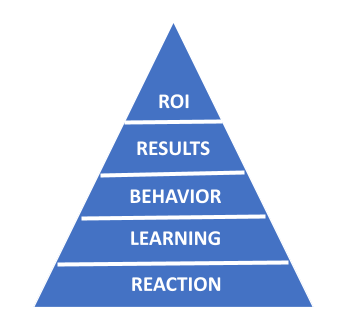You’re attending a training program you’ve waited months to get into. You participate, ask questions, network with your peers and leave with a fulfilling experience.
Inspired and eager, you return to your home base, ready to apply what you’ve learned. You re-plan, refocus and teach others. But you are surprised when you start running into resistance. You may hear sayings like, “That’s not how we do it around here,” or “To make that change would require new processes and procedures, we don’t have time to make the changes.”
You’re puzzled, frustrated and left wondering what to do. Meanwhile, your organization is wondering why it’s not getting a return on its investment from sending you to a training program. The leadership is puzzled and frustrated as well and asks your supervisor why we’re not seeing a positive ROI in the training initiative. The supervisor, who is on a tight schedule to deliver capability, doesn’t feel they can take the risk to try that “something new” that you learned from training. Now they’re puzzled, frustrated and disappointed as well.
This is the perfect storm that can ultimately lead to a derision toward training. But what is really going on?
Scenarios like this are not uncommon. In an environment where performance standards keep increasing the pressure on all, the challenge becomes not just learning but implementation. While the talk is about creating a culture of growth-mindedness and self-guided learning, scenarios like the above will continue to build counterforces preventing organizations from improving their performance. We won’t fully benefit from training unless the organizational leadership, first-line supervisors, learners and content providers all understand and fulfill their specific roles to make training last and get a return on the investment.
In short, training alone, which expects learners and organizations to self-actuate in their training goals, cannot reach its goals without an undertaking where this new understanding of the convergence of all is needed to be successful. It is not a standalone initiative, but rather a coming together on the purpose and a follow-on plan of action.
We know organizations seek performance improvement on the training initiatives. Understanding the goals and the integrated follow-up is what drives a positive ROI. Thought leaders in the field of learning and development have worked for years to build models for workforce developers and trainers to use. Let us explore a representative model and see how realizing improved performance requires participation from multiple players in an organization.
The Kirkpatrick Model
Often, organizations build their L&D function moreso because they feel it is the right thing to do rather than for the purpose of getting a return on the investment. L&D is often looked to as a place to fix people and things. The challenge with this approach is that it is difficult to justify the money and time being spent on the training as compared to measuring the return it is bringing the organization. One model that is often used to measure training impact is Kirkpatrick’s Levels of Evaluation.

- Reaction: Often on a Likert scale of 1 to 5 and sometimes open-ended remarks are allowed as well. The focus here is on what the learner thought of the experience with not much that helps the organization see the return-on-investment.
- Learning: Often the concept of a pre-test and post-test is used to measure what the learner knows at the beginning of the session as compared to what they know after going through the training. In some cases, the concept of formative and summative evaluation is included. In the case of formative evaluation measures of progress happen at various stages during the program to see learning progress. In a summative approach, an evaluation is done at the end to see what has been learned. Here we can at least measure if the individual learned something as compared to having enjoyed the experience. This however still leaves us short in measuring the ROI.
- Behavior: Sometimes, more of a challenge to evaluate personality measures. and this generally happens over a longer period of time. In some cases, more of a 360-feedback model can be utilized to measure behavioral changes. While behavioral change is part of the process it may not provide a direct correlation to the return-on-investment and the process is longer term.
- Results: Here, having a dashboard to measure metrics related to the quality and cost of work along with customer satisfaction is often used. This measure over time should allow for tracking of performance as compared to changes in the approach to work. There are often organizational support structures related to systems, structures and processes that can also impact the results seen. While this makes it easier, the direct line of sight to training is still often in question.
- ROI: The starting point here is to determine where performance needs to improve. From there, determining the content and cost of developing and delivering training need to be calculated. At the same time, the measure of success in achieving an improved ROI will need to be identified, along with how it will be measured. Areas that are often looked at are increasing productivity, improving performance, new product development or increased customer satisfaction.
The Ring Model
As stated earlier, to achieve the ROI of training and the desired performance goals for the organization, it takes more than the learner attending training and bringing that experience back home.
Achieving this ROI is, at its very core, a team effort and this means the team needs players that will work together. We need to transform our perception of what the training accomplishes and what the environment accomplishes if we are really after increased workforce performance. If we continue to think getting trained is the end game, we will never reach our performance goals.
An ongoing topic in L&D is: Who is responsible for providing effective training? Is it the organization, the learner or the trainer? From our experience, unless all are engaged and committed to making a difference, the learning is not optimum. It starts with the organization making a commitment to develop its talent. Done correctly, having a recognized L&D function can benefit the organization in multiple areas including recruiting individuals, developing them to better perform and retaining them in the organization. From a succession planning perspective, it helps to know who has what skills and can be promoted as well.
Creating a culture where training is related to performance on the job puts the value into having the individual spend the time and make the effort to not just attend but to engage in the learning process. Everyone has a role in getting the training ROI to a targeted level. The organization and its leadership need to determine the importance of having a trained workforce. Are the roles of the individuals stagnant or are they required to continually learn to be effective in the work they do? The individual or learner must be committed to making the effort to learn how to be better and become more effective.
“The Guide,” as we call them, needs to help an individual develop. We refer to the role of a guide rather than a trainer since a trainer is often seen as limited to delivering a course. In today’s changing world this is no longer enough. The trainer must evolve into being a guide to help the learner both formally and informally. To not only share content but to help the learner understand the level of application. The process does not end at the end of the course but continues on where the guide becomes a coach in helping in the ongoing improvement process and with time develops trainees to the point where they can help and mentor others. Building the ecosystem is key.

Now we will discuss how the roles identified in the Ring model would act at each level of the Kirkpatrick Model:
- Reaction: The learner, in addition to taking the training, should be providing feedback on the training experience, including what worked well and what could be improved. This does not stop at the end of the course but is a check-in process, for example quarterly for a period of time, for example, a year, to provide feedback on not just what was learned but to the extent what was learned has been able to be implemented in the ongoing work process. The guide should design and deliver engaging and effective training sessions. The learner’s organization should gather and analyze feedback from learners to improve future training programs and determine what training is needed.
- Learning: As one may ascertain from the label, the key player here is the learner. The ideal learner would actively engage in the training, participate in activities and absorb the presented material. They would network with their peers, faculty and expert guests. They may extend their experience by delving into additional content to further their exploration of the topic. The guide, must develop clear learning objectives, deliver content effectively and provide opportunities for practice and reinforcement. The ideal content provider would aim to design their content and the learning environment to be inclusive, balanced and psychologically safe to ensure all learners feel welcome and supported during the engagement. They would hone their delivery style to inspire the learners to action, not just during the time of the engagement, but for months beyond. The experience should be designed to guide the learner to change not only what they learn but also how to apply the learned concepts through follow-on opportunities and to engage with the learners to continue to culture that behavioral change or application of the concepts that were taught. Finally, the learner’s organization should monitor participants’ progress and provide support as needed to ensure learning objectives are met. Providing support may mean checking in during the class with the learner to see if things are going well.
- Behavior: Here the learner’s role is to apply the knowledge and skills gained from the training in their work, seeking to instill new behaviors through daily practice. The guide’s focus is to provide support and partnership, providing resources and support to help learners transfer their learning to real-world situations. The learner’s organization has a crucial and often forgotten role here: To create an environment that encourages and reinforces desired behaviors, such as providing opportunities for practice and feedback.
- Results: Here, the learner should contribute to achieving organizational objectives through improved performance resulting from the training. The guide’s focus is aligning training objectives with organizational goals and measuring the effectiveness of training. This requires the guide to have a close relationship with the learner’s organization. The learner’s organization defines clear performance metrics and tracks change in key indicators to assess the impact of training on organizational success. Each level involves collaboration between the learner, the training provider and the learner’s organization to ensure the success of the training program and its alignment with organizational goals.
- ROI: Here’s where it all comes together. The learner has developed new skills that can support organizational strategies. The organization and its leadership have created a culture that not only supports individuals in their learning and development efforts but has also provided line-of-sight measures that link to what has been learned and applied. The guide becomes an orchestrator in not only helping individuals learn and develop new skills but continues on to provide coaching and support while at the same time helping others in the organization develop the mentoring skills to support others.

Call to Action
There are several actions organizations can take to foster an environment that focuses on gaining a strong ROI from the training they invest in. It starts with breaking the unhealthy culture of expecting the learner to attend a class, return home and be the change the organization wants without the support.
Per the Ring Model, recognize that seeing the performance improvement gained from training is truly a team sport, requiring the learner’s organization, the learner and the guide to fulfill their unique roles with equal dedication and tenacity.
Put the roles into practice by creating a community partnership and dialog between learner’s organization, the learner and the guide.
Formalize a success agreement pledging support between and signed by all three parties, pledging to provide requisite environments for feedback, mutual support and pursuit of the learner’s organizational goals, with specific line-of-sight measures.
In organizations we have worked with, including our current work at the Defense Acquisition University Leadership Center, we have been making inroads toward realizing the Ring Model. We’ve implemented protocols in our courses where we actively engage with the learner’s supervisor, the learner and as deeply into the organization as possible. One of the current methods we use to boost the organizational impact of the learning in our role as guides is to focus the learners’ training on solving an organizational challenge. We call this the “Workplace Challenge.” The goal of this challenge is to change a behavior, function or process in the organization. There is an implied default that the organization must change to some degree for the challenge’s solution to be valuable. This protocol aims to directly improve organizational performance, while also developing and upskilling the learner.
The road to adjusting to a performance culture and seeing the training ROI is complex and will require patience and commitment from all parties. New practices must be developed to support the ongoing training and development individuals receive. The culture of the organization led by its leadership must commit to being involved in setting the goals and supporting the organizational changes needed to be successful.
















